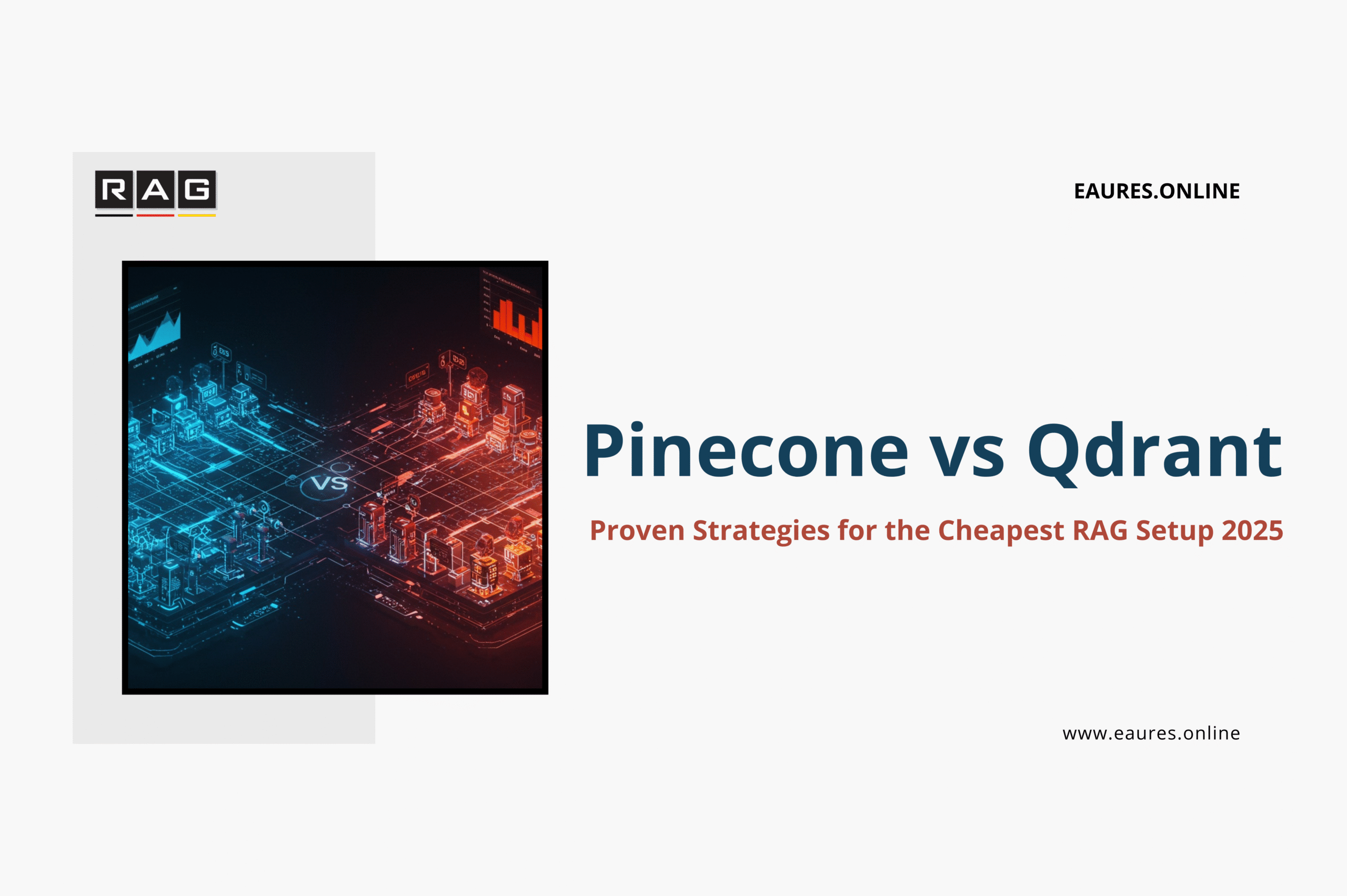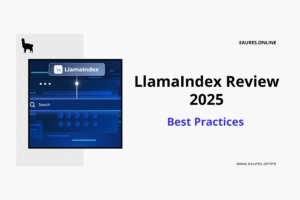Table of Contents
Pinecone vs Qdrant: Cheapest RAG Setup 2025
TL;DR — The Cheapest RAG Setup in 2025
If your goal is the Cheapest RAG Setup without sacrificing reliability, start by matching your workload shape to the right vector database posture:
- Prototype / small-scale (<1M vectors, modest QPS): A single-node Qdrant container with persistent storage on a cost‑efficient VM is usually the least expensive path, especially when you compress embeddings and keep queries low-latency with prudent HNSW settings. When you want hands‑off infrastructure, Pinecone serverless offers predictable spend for spiky traffic with almost zero ops overhead.
- Growth (1–50M vectors, predictable traffic): For the Cheapest RAG Setup at this scale, a managed Qdrant Cloud cluster with autoscaling and snapshots can be cost‑optimal if you can keep hot shards small and memory tight. If you value operational simplicity above all, Pinecone can remain competitive by removing infra labor, and its managed indexing can save a lot of engineering time.
- Enterprise (50M+ vectors, strict SLOs): Cost parity depends on data residency, compression, and read/write ratios. Pinecone often wins on “cost of certainty” (SLA, tooling, stability), while Qdrant is compelling when you can invest a little infra time to compress embeddings and right‑size nodes.
The biggest lever, regardless of Pinecone and Qdrant, isn’t the database—it’s fewer, smaller, smarter embeddings plus aggressive reranking. Make the vectors cheap first; the store then becomes inexpensive almost by default.
What “Cheapest” Actually Means for RAG in 2025
The four pillars of cost
When teams ask for the Cheapest RAG Setup, they often look only at the database bill. In practice, total cost is the sum of:
- Storage & memory: Vector count × dimension × precision × index overhead.
- Compute for ingest & search: Upserts, index building, ANN graph maintenance, and query concurrency.
- Networking & egress: Cross‑AZ/region traffic, especially if models live elsewhere.
- Operations: Upgrades, snapshots, incident response, and evaluation—labor that Pinecone can absorb or that Qdrant can minimize with steady-state setups.
A rigorous plan considers all four. For many teams, the “cheapest” solution is the one that reduces embeddings and cuts reranker tokens, not the one that negotiates the last cent on storage.
Workload shapes that change the math
- Read‑heavy search with steady QPS: Memory‑efficient quantization and small hot shards help Qdrant self‑hosting shine. Carefully managed serverless capacity can make Pinecone cost‑predictable, especially when peak is well above average.
- Write‑heavy with frequent re‑indexing: Managed services like Pinecone save substantial ops time during schema changes and re‑ingestion. Qdrant can also manage this well if your pipeline batches upserts and uses snapshots intelligently.
- Burst traffic / cyclical loads: Serverless or autoscaling options in Pinecone reduce your “idle tax.” A lean Qdrant cluster that scales via VM templates can match it if your DevOps is mature.
A Short Primer on Pinecone and Qdrant
Pinecone: managed vector database with serverless simplicity
Pinecone is a fully managed vector database with simple APIs, focus on reliability, and painless scale. It’s particularly attractive when you prefer the vendor to handle cluster sizing, failover, and index maintenance. For feature depth and lifecycle details, the Pinecone documentation gives a good overview inside practical guides and API references. Teams that need predictable operations often weigh the labor savings against raw infra costs and find that Pinecone remains competitive when engineering time is scarce.
From an architecture standpoint, Pinecone’s collections, namespaces, and managed indexing let you evolve schemas with fewer foot‑guns. That’s a real cost lever for many organizations seeking the Cheapest RAG Setup that keeps SLOs intact.
Qdrant: open‑source first, with an efficient HNSW core
Qdrant started as an open‑source vector database built on HNSW, growing into a polished engine with filtering, payloads, snapshots, and quantization. The official Qdrant documentation covers the architectural model, index options, and payload filtering, while Qdrant Cloud adds managed deployments and autoscaling. If you can containerize and operate a small footprint, Qdrant is often the least cash‑outlay route for Pinecone and Qdrant comparisons, particularly at low to mid scale.
Ecosystem compatibility
Both Pinecone and Qdrant integrate well with popular frameworks. For higher‑level orchestration, the LangChain retrieval docs show end‑to‑end patterns, and LlamaIndex’s documentation provides templates for ingestion, node parsing, and evaluation. Under the hood, the ANN landscape is driven by HNSW; the original paper on the structure—Efficient and robust approximate nearest neighbor search (HNSW)—is a useful reference when you tune ef and M.

The Real Cost Center: Embeddings and Reranking
Dimensionality, precision, and index overhead
The size of your vectors dominates storage and memory. A 1536‑D float32 vector is ~6 KB before metadata; with index overhead, that scales quickly. To approach the Cheapest RAG Setup, shrink vectors before you debate databases:
- Use smaller‑dimension models when quality allows. The OpenAI embeddings overview explains trade‑offs among families.
- Consider alternative encoders such as Nomic embeddings that offer competitive quality at different dimensions and licensing models.
- Quantize: scalar or product quantization can cut memory significantly. Qdrant’s quantization tooling and Pinecone’s managed indexing both benefit from lower‑precision inputs.
Hybrid retrieval and MMR
Combining sparse signals with vectors often reduces the top‑k you need to fetch. When using Pinecone and Qdrant, you can blend lexical and semantic search (e.g., BM25 + vector), then apply Maximal Marginal Relevance (MMR) for diversity. The hybrid pass improves recall so your reranker sees fewer, better candidates—this reduces model tokens and improves perceived quality.
If your stack needs a portable, on‑prem fallback, the FAISS library helps you validate ANN parameters locally and evaluate hybrid vs pure vector approaches before paying for cloud capacity.
Rerankers: value over volume
Rerankers can increase answer quality at lower top‑k, which lets you shrink or slow down your vector tier. The Hugging Face MTEB leaderboard contains reranking benchmarks that help you pick a model aligned to your latency budget. A smart reranker often saves more than it costs.
Pinecone and Qdrant: Cost Levers You Actually Control
1) Shrink what you store
- Prune near‑duplicates during ingestion.
- Use smaller chunks (e.g., 200–400 tokens) only when it improves hit‑rate; otherwise larger chunks reduce index entries.
- Strip noisy fields before embedding. Metadata can live as payloads/filters without being embedded.
2) Compress what remains
- Down‑cast float32 → float16 where quality permits.
- Use scalar or product quantization; keep uncompressed originals off the vector path (in object storage) for occasional re‑index.
3) Search less, but smarter
- Tune k, ef, and M; use MMR and domain filters to avoid pulling dozens of neighbors you’ll never display.
- Cache frequent queries and pre‑compute answers for hot paths.
4) Keep routing local
- Co‑locate embeddings, vector DB, and LLM in the same AZ/region to avoid egress. Simple placement decisions can make your Cheapest RAG Setup measurably cheaper.
Architecture Patterns for the Cheapest RAG Setup (2025)
Pattern A — Single‑node Qdrant + simple reranker (lowest cash burn)
- When: <1M vectors, predictable traffic, steady updates.
- Why: Minimal infra, excellent latency, strong filtering, easiest to run in a single VM or container.
- How: Dockerize Qdrant with a persistent volume; use scalar quantization; batch upserts; adopt a lightweight reranker. Keep snapshots on cheap object storage.
- Tooling: Use FAISS locally for parameter sweeps and export to Qdrant once settled. If your application has structure, LlamaIndex’s documentation offers helpful node parsers and evaluation recipes.
Pattern B — Pinecone serverless + hybrid retrieval (lowest ops cost)
- When: Spiky traffic, prototypes moving to production, small teams who want fast time‑to‑value.
- Why: Infrastructure disappears; you pay for searches and capacity rather than VMs.
- How: Encode with a small‑dimension model; do sparse+dense retrieval; apply MMR; rerank top‑25; stream answers. The Pinecone documentation has concise examples for namespaces and collections to keep tenants separate.
Pattern C — Managed Qdrant cluster + autoscaling (balanced)
- When: 1–50M vectors, need filters and consistent latency, moderate writes.
- Why: You still control index settings and compression, while letting the provider handle failover and scaling.
- How: Split collections by product/domain to keep HNSW graphs small; tier older vectors to cheaper nodes; snapshot daily.
Pattern D — Hybrid store (pgvector + Pinecone/Qdrant)
- When: Business logic demands transactional joins with vector semantics.
- Why: Keep user/permission data in PostgreSQL, and offload high‑recall ANN to Pinecone/Qdrant.
- How: Use pgvector for small or latency‑insensitive embeddings, and delegate hot search to your ANN tier.

Step‑by‑Step: A Reference “Cheapest” RAG Build
Ingestion: do less work, better
- Normalize & dedupe: Hash paragraphs; remove exact/near‑duplicates early.
- Chunk with intent: Prefer semantic splits over fixed windows to reduce chunk count.
- Select a small encoder: Pilot with 384–768‑D models if quality holds; test on your retrieval eval set.
- Attach selective metadata: Keep only what’s needed for filtering. Avoid embedding metadata.
For a full, pragmatic pipeline with FastAPI and FAISS, the guide on building a production‑ready FastAPI FAISS RAG API explains ingestion, indexing, search, and Docker deployment inside a realistic API flow.
Indexing: tune for price, then speed
- Qdrant: Start with HNSW defaults; slowly increase M and ef_constructor until recall meets target, then clamp ef_search for your latency budget. Enable scalar quantization for memory relief.
- Pinecone: Create collections with sensible dimensions and metadata schema; rely on managed indexing to pick robust defaults and keep your own knobs to a minimum.
Retrieval: hybrid, filtered, reranked
- Hybrid retrieval: Use lexical scores (BM25) to pre‑select candidates; add ANN neighbors from Pinecone and Qdrant; merge with reciprocal rank fusion.
- Filtering: Push tight filters (tenant, language, product area) to reduce candidate sets.
- Reranker: Choose one strong reranker—for example a BGE variant from the MTEB leaderboard—to reorder top‑25 for the generator.
Generation: fewer tokens at higher utility
- Fetch only what you need (top‑k post‑rerank), use short snippets, and prefer structured prompts. If your RAG flows into analytics, the workflow in Automate Data Analysis with Python + LLMs demonstrates validation, profiling, and context injection patterns that keep token usage predictable.
Evaluation: measure before you spend
- Build a small gold set of user questions and relevant sources.
- Track retrieval precision@k, MRR, and answer faithfulness.
- Change one knob at a time; log costs alongside quality.
For an architecture‑first walkthrough that highlights trade‑offs among chunking, indexing, and retrieval, see Build a RAG App fast with FastAPI and FAISS, which outlines pragmatic defaults that tend to minimize both compute and storage.
Pinecone vs Qdrant: A Cost Model You Can Adapt
Rather than hard‑coding numbers that age quickly, use a repeatable model for your Cheapest RAG Setup:
Storage cost (monthly)
Vectors × Dimension × BytesPerValue × IndexOverhead × RedundancyFactor → Memory/Storage
Memory/Storage × ProviderRate → StorageCost
- Reduce Dimension (e.g., 384–768).
- Lower BytesPerValue via float16 or quantization.
- Trim IndexOverhead by tuning HNSW (M) and avoiding oversized top‑k.
Query cost (monthly)
QueriesPerMonth × (ANNLatency × CPU/GPURate + RerankCost + NetworkEgress) = QueryCost
- The ANNLatency includes cache hit ratios and ef_search.
- RerankCost (tokens/latency) often dominates; a better reranker can let you cut top‑k by 2–4×.
- NetworkEgress grows if your model and DB sit in different regions—co‑locate them.
Ops cost (monthly)
(Engineers × Hours × FullyLoadedRate) + Tooling
- Pinecone reduces this materially; with Qdrant, you can keep it low via simple, stable single‑node or small‑cluster setups and periodic snapshots.
Example scenario
- Data: 5M chunks; 384‑D embeddings with scalar quantization; tight filters.
- Traffic: 1M queries/month; 90% read, 10% write.
- Goal: Balanced cost and simplicity.
Pinecone path: Minimal ops cost; pay‑as‑you‑go for reads/writes with managed indexing. You’ll likely spend more on queries than storage if you keep dimensions small and cache intelligently. Confirm current options on the Pinecone pricing page and map them to your actual query mix.
Qdrant path: Low infrastructure cash cost with a tuned single node or modest cluster, especially with scalar quantization. Managed Qdrant Cloud keeps ops light while preserving knob access; check features and deployment choices in Qdrant’s documentation as you size memory and shard strategy.

Reliability, Backups, and SLOs
Backups and snapshots
Both Pinecone and Qdrant support operational continuity strategies. Qdrant snapshots let you copy collections to object storage, while Pinecone handles backups behind managed operations. Whichever you choose, schedule regular snapshots, test restores, and keep your metadata (document store) backed up independently.
Multi‑AZ/Region
For the Cheapest RAG Setup at higher reliability, prefer single‑region multi‑AZ with durable snapshots. Cross‑region replication is powerful but increases cost; if you’re latency‑sensitive across continents, use per‑region indexes and route queries locally.
Observability
Instrument query counts, ef_search, top‑k, rerank latency, and cache hit ratios. Observability is a compounding cost saver—tight feedback loops help you keep both ^k and token counts low.
Security, Compliance, and Data Residency
- Encryption: Ensure encryption at rest and in transit; confirm KMS/CMK options if you’re in regulated environments.
- Access control: Namespaces/collections per tenant, signed tokens, and attribute‑level filters for PII.
- Data residency: Keep embeddings and LLMs in‑region; consult service docs for residency assurances (see Pinecone documentation and Qdrant documentation for current statements).
- Auditability: Log query inputs/outputs and store explainability breadcrumbs—useful for both debugging and compliance.
Performance Tuning Cheat Sheet (for Price‑First Builders)
Vector creation
- Prefer fewer, bigger chunks until eval says otherwise.
- Use smaller‑dimension encoders; avoid embedding metadata.
Index settings
- Start with HNSW defaults, then:
- Increase M gradually to recover recall (watch memory).
- Raise ef_search only as needed for your SLO.
- Turn on quantization once quality holds.
Retrieval
- Keep top‑k minimal (10–25) before rerank.
- Apply MMR to reduce near‑duplicates.
- Push filters into the vector query to limit candidate sets.
Reranking & generation
- Select one strong reranker; cut top‑k to keep model tokens low.
- Keep context windows small and structured.
Decision Framework: When to Choose Pinecone and Qdrant
- Choose Pinecone when:
- Ops time is expensive or scarce.
- You need fast scale‑up, predictable SLOs, and managed upgrades.
- Your workload is spiky, and serverless pricing maps well to utilization.
- Choose Qdrant when:
- You want the absolute Cheapest RAG Setup at small to mid scale and can manage a container or two.
- You need deep control over index knobs and payload filtering.
- You can save big with quantization and local data placement.
The right answer for Pinecone and Qdrant is often both over time: Qdrant for early thrift and custom control, Pinecone when you need to hand the pager to a provider and buy back engineering focus.
Practical Build Guides and Templates (Recommended Reading)
When you are ready to put this into practice, a Cheapest RAG Setup benefits from hands‑on, production‑minded tutorials. For a pragmatic path from prototype to deployment, the tutorial on building a RAG app fast with FastAPI and FAISS walks through architecture, indexing, retrieval, and evaluation with defaults that translate directly to either Pinecone or Qdrant. If you prefer a fully productionized API, the guide to a FastAPI FAISS RAG API covers ingestion, search, testing, Dockerization, and deployment details.
For teams turning analytical datasets into RAG‑ready knowledge, the end‑to‑end workflow in Automate Data Analysis with Python + LLMs shows how to validate CSVs, profile features, add retrieval context, and generate actionable outputs without ballooning token spend.
Finally, if developer productivity is part of your cost calculus, a hands‑on comparison of tools in the best AI code assistants in 2025 can help your team ship faster—which is often the cheapest move of all.

FAQ: Pinecone and Qdrant for the Cheapest RAG Setup
Q1: Is self‑hosting always cheaper than a managed vector DB?
Not always. Self‑hosting Qdrant can be the cheapest in cloud bills, but once you include engineering hours for upgrades, monitoring, and incident response, Pinecone can be cheaper overall—especially under spiky or fast‑changing workloads.
Q2: How do I pick the “right” embedding size for cost?
Pilot on a small evaluation set. Many domains do well with 384–768‑D encoders. If you need 1024/1536‑D, ensure quality benefits justify the extra memory and compute.
Q3: What’s the single biggest cost mistake?
Embedding too much. Aggressively dedupe and avoid embedding metadata or boilerplate. Every unnecessary vector multiplies storage, indexing, and query cost.
Q4: Can hybrid search really reduce my bill?
Yes. Sparse+dense retrieval increases early recall, which lets you fetch fewer neighbors and rerank fewer candidates. That reduces both vector compute and LLM tokens.
Q5: Should I shard by tenant or by domain?
Shard by a criterion that keeps graphs small and coherent. Many teams shard by domain or product line, with tenant isolation via namespaces/filters.
Q6: Where should I store the original documents?
Keep originals in object storage. Store only compact snippets or pointers in the vector store. This keeps vectors small and your index nimble.
Conclusion: A Playbook for 2025
The Cheapest RAG Setup isn’t a single product choice—it’s the discipline of embedding less, compressing more, retrieving smarter, and co‑locating your stack. With those principles in place, both Pinecone and Qdrant can be remarkably affordable:
- Pick Qdrant when you want the leanest cloud bill and you’re comfortable with light ops.
- Pick Pinecone when speed to production, reliability, and minimized operations are paramount.
Use the cost model here, validate with a small eval set, and iterate. When you tune vectors first, the database bill becomes a rounding error—and that’s how you win the “cheapest” game in 2025.




